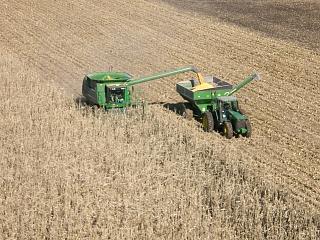 Corn and soybean harvest this year at Noland Farms was a true adventure for our family. Wet soil conditions often kept us out of the fields for extended periods of time, and long lines of trucks with high-moisture corn led many grain elevators to hold limited hours, some open just four hours each day. As manager of an ADM grain elevator last year, I learned that both farmers and commercial elevators are not equipped to handle large quantities of high-moisture corn. This summer, we updated an additional on-farm, grain-drying system in anticipation of the logistical logjam during harvest. This additional facility allowed us less dependence on commercial elevators, which kept our combine running when the weather cooperated. The ability to dry corn through on-farm facilities also strengthened our relationship with the propane deliveryman … even making trips to fill the tanks on Thanksgiving! As I previously mentioned, we are excited to implement improvements to our grain handling facilities for next year.
Corn and soybean harvest this year at Noland Farms was a true adventure for our family. Wet soil conditions often kept us out of the fields for extended periods of time, and long lines of trucks with high-moisture corn led many grain elevators to hold limited hours, some open just four hours each day. As manager of an ADM grain elevator last year, I learned that both farmers and commercial elevators are not equipped to handle large quantities of high-moisture corn. This summer, we updated an additional on-farm, grain-drying system in anticipation of the logistical logjam during harvest. This additional facility allowed us less dependence on commercial elevators, which kept our combine running when the weather cooperated. The ability to dry corn through on-farm facilities also strengthened our relationship with the propane deliveryman … even making trips to fill the tanks on Thanksgiving! As I previously mentioned, we are excited to implement improvements to our grain handling facilities for next year.
During harvest, each member of the family plays a key role in maintaining the forward progress of our operation. My grandfather, Neil, is our primary combine operator, and after 60 years, he has mastered the fine art of combining corn and soybeans. Once the combine is put away in the shed, he winters with my grandmother in Florida. They are celebrating their 60th wedding anniversary this year.
Dennis is our secondary combine operator, but focuses primarily on machine and grain facility maintenance during the fall. Keeping the machines serviced and running, unloading trucks at the elevators and drying corn are his core responsibilities.
Duane allocates his time driving semis to our grain facilities or the elevator, operating the grain cart in the field and working ground with our tillage tractor in harvested fields.
My responsibilities include monitoring grain handling and quality at our facilities, driving semis to and from the fields and contributing to our tillage progress. We are also fortunate to have additional family and friends provide labor throughout harvest.
Since the completion of corn and soybean harvest, our responsibilities have shifted to cleaning up equipment, paperwork and preparing equipment for planting. Compiling harvest data, producing yield maps, and purchasing seed and chemicals for the 2010 crop year have allowed for indoor, warm office work during the cold weather. Producing yield maps from our monitor’s harvest data provides a “2009 report card” for the corn and soybeans planted in spring. This information is also analyzed to determine which corn and soybean hybrids produced high yields and should remain in the “line-up” of seed to be planted in 2010. Once the office work has been completed, we will begin preparing equipment for planting. Each winter, we thoroughly inspect our planter for issues that could potentially impede the spring’s planting progress. Preventative maintenance is a crucial factor in keeping equipment performing throughout the year. We currently use a sprayer that is 90 feet wide to apply liquid chemicals and fertilizer. With a span roughly the length of a basketball court, controlling the amount and direction of the product applied is very important for environmental and economical reasons. This winter, we are to dividing the 90 foot section into five independently-controlled spray sections to increase efficiency. We anticipate the ability to decrease overlap spray application, thus use less product, with this precision tool.
